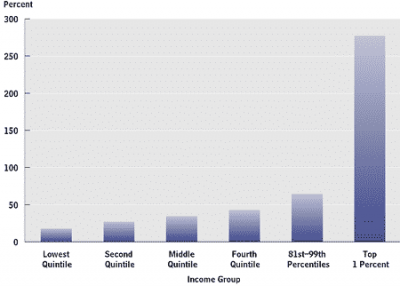Chart of the Day: US Income Growth 1979-2007
Since everyone is talking about increased wealth and income disparities in the US, it is useful to have some numbers to point to. You saw yesterday’s chart of the day on income as measured by 2008 tax returns. Today’s chart of the day comes from the US Congressional Budget Office (hat tip Mark Thoma).
I like the fact that a man named Edward Harris prepared the data. Go Edward!
The CBO writes:
From 1979 to 2007, real (inflation-adjusted) average household income, measured after government transfers and federal taxes, grew by 62 percent. That growth was not equal across the income distribution: Income after government transfers and federal taxes (denoted as after-tax income) for households at the higher end of the income scale rose much more rapidly than income for households in the middle and at the lower end of the income scale.
In a study prepared at the request of the Chairman and former Ranking Member of the Senate Committee on Finance, CBO examines the trends in the distribution of household income between 1979 and 2007. (Those endpoints allow comparisons between periods of similar overall economic activity.)
After-Tax Income Grew More for the Highest-Income Households
CBO finds that between 1979 and 2007:
- For the 1 percent of the population with the highest income, average real after-tax household income grew by 275 percent (see figure below).
- For others in the 20 percent of the population with the highest income, average real after-tax household income grew by 65 percent.
- For the 60 percent of the population in the middle of the income scale, the growth in average real after-tax household income was just under 40 percent.
- For the 20 percent of the population with the lowest income, the growth in average real after-tax household income was about 18 percent.
[…]
Market Income Shifted Toward Higher-Income Households
The major reason for the growing unevenness in the distribution of after-tax income was an increase in the concentration of market income—income measured before government transfers and taxes—in favor of higher-income households. Specifically, over the 1979 to 2007 period, the highest income quintile’s share of market income increased from 50 percent to 60 percent (see figure below), while the share of market income for every other quintile declined. In fact, the distribution of market income became more unequal almost continuously between 1979 and 2007 except during the recessions in 1990–1991 and 2001.
Source: Trends in the Distribution of Income – Directors Blog, Congressional Budget Office

The US needs progressive taxation to end the growing inequality before the unrest increases to a level that will only mean violence. Without the threat of Communism that made politicians see sense in the thirties, the status quo in policy will mean that the US will move faster and faster to anarchy.
Given that the US is third from bottom in social mobility (behind Italy and UK) it’s hard to disagree with this.
I think that Israel has even greater inequality and there have been demonstrations about the inequality there already will mean that things are changing everywhere.
I assume since the increases are in “household” income, it does not adjust for an increase in two wage earners in the bottom 4 quintiles. A lot more two income households today than in 1979 and not a factor in the top 1% I think. Any data to support this theory?
excellent observation ichabod. i think this report validates your point: https://blog.american.com/2011/10/income-inequality-can-be-explained-by-household-demographics/
Sorry, that is rubbish. Real median wages peaked in 1973. It’s not just demographics that are at play.
This article demonstrates that the very articles that Pethokoukis cites in his piece are saying this too:
https://www.cjr.org/the_audit/aeis_myth_of_equality.php
I added this at Mark Perry’s site:
The analysis incomplete. Demographic differences are relevant only to the degree they hold constant the differences in income inequality, which all studies show they do not. One need only look to median income which peaked in 1973 to understand that the average worker has not seen wage gains over the preceding generation and that median household income has increased due primarily to increased hours and labour participation of women.
Everything Mark writes must be completed by analysing how the quntiles relative demographics change. it is not enough to cite absolute demographic differences.
Bottom line: If you want to make an argument that specific extraneous variables have changed in two sample comparison groups, rendering comparison difficult, you must do one of two things: hold those values constant in one group or allow random variation – and re-run the assessment to make the analysis valid. Doing so reveals that income inequality has increased.
You cannot argue that differences in those extraneous variables between groups accounts for the changes in the variable assessed without controlling for change over the period of time assessed. this is standard statistical analysis.